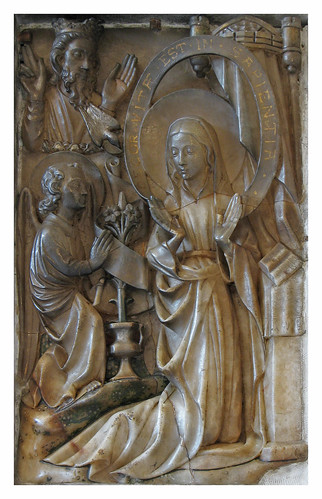 It is often noted that pregnant mothers have a certain radiance and 'glow' about them, physically attributed to the extra flow of blood around their bodies. But of course, it is well to think that this is a beautiful external sign of the inner joy that an expectant mother experiences in her spirit as new life grows and develops within her womb. During Advent, the Church focuses her attention on several persons, and one of these is a pregnant mother, who is not just aglow with joy and her pregnancy, but also beautiful and radiant with divine grace.
It is often noted that pregnant mothers have a certain radiance and 'glow' about them, physically attributed to the extra flow of blood around their bodies. But of course, it is well to think that this is a beautiful external sign of the inner joy that an expectant mother experiences in her spirit as new life grows and develops within her womb. During Advent, the Church focuses her attention on several persons, and one of these is a pregnant mother, who is not just aglow with joy and her pregnancy, but also beautiful and radiant with divine grace.This person, of course, is the Virgin Mary, and the well-known sentence which points to this two-fold 'glow' comes from St Luke's account of the Annunciation. The phrase is most familiar to us in this translation: "Hail, full of grace, the Lord is with you", which is itself a translation of the Latin Ave gratia plena, Dominus tecum. The key word in this phrase, in St Luke's original Greek, is kecharitōmenē which becomes gratia plena or 'full of grace'. Attention to the words used is important, and following St Thomas Aquinas' methodology, we should begin by looking at the ordinary meaning of the words charis and gratia. In this way we hope to have some insight into what it is that the evangelist says Mary is full of!
'Charis' in Greek can be translated as 'favour' (and indeed some translations of the Bible do use this meaning so that Mary is the 'highly favoured' one), but 'charis' was also used to refer to "an adornment of social relationships or moral qualities", like gold on silver, as Homer put it. In other words, someone who possessed charis was 'gracious', and so, beautiful or attractive in her behaviour both socially and morally. As such, there is a another sense of charis which is 'attractiveness, charm, producing favourable impressions'. For one who is gracious and graceful (like a ballerina, say) attracts our eye and wins our admiration, love and favour. So, when St Jerome translated the Greek of St Luke's phrase, he used gratia, which also has as its primary meaning 'that which is pleasing, charm, attraction'.
Therefore, Mary is one who is very pleasing to God and exceedingly beautiful in his sight. But this beauty of which we speak does not come from her own efforts or a good gene pool! She is beautiful to God because she is graceful: full of divine grace. For grace renders human beings pleasing to God. And just as we might say that someone is graced with good looks or an artistic talent, so Mary's beauty and grace is not something she has earned, but she was born with it. Indeed, grace, which makes one pleasing to God, was given to her by God from the very moment of her conception. For the Greek phrase St Luke uses is a perfect passive participle, so that, as Pope John Paul II says, "We should not simply say 'full of grace' but 'made full of grace' or 'filled of divine grace', which clearly indicate that this is a gift from God to the Virgin. The term, in the form of perfect participle, confirms the image of a perfect and lasting grace which implies fullness". The fullness of the grace that is given to Mary thus implies that she was not just conceived and born with grace, but she was given grace upon grace to nurture and develop this grace. Throughout her life, she cooperated with God's grace, so that she would grow and be perfected in charity. So, because she is full of grace, she also acts graciously, and as she is graceful, so she is beautiful and deserving of our love and highest admiration. Moreover, because she is beautiful in God's eyes, she is favoured by him and he chooses her as the one who is worthy to bear the Son of God in her womb. Thus, she is aglow with grace and also with the glow of her pregnancy.
 Seen in this light, then, the feast of the Immaculate Conception rightly celebrates the full meaning of Mary being hailed by the angel as kecharitōmenē. So, as a 4th-century Marian antiphon that is used for the feast of the Immaculate Conception puts it: tota pulchra es, Maria, "you are all beautiful, Mary, and the original stain [of sin] is not in you. You are the glory of Jerusalem, you are the joy of Israel, you give honour to our people". Mary is beautiful, pleasing, attractive, because she is made full of grace, and we rightly rejoice in this and are grateful to God that she was made graceful from her very beginning. For through her and the fruit of her womb, Jesus, we too can be made full of grace, we too are rendered pleasing to God and receive his divine favour.
Seen in this light, then, the feast of the Immaculate Conception rightly celebrates the full meaning of Mary being hailed by the angel as kecharitōmenē. So, as a 4th-century Marian antiphon that is used for the feast of the Immaculate Conception puts it: tota pulchra es, Maria, "you are all beautiful, Mary, and the original stain [of sin] is not in you. You are the glory of Jerusalem, you are the joy of Israel, you give honour to our people". Mary is beautiful, pleasing, attractive, because she is made full of grace, and we rightly rejoice in this and are grateful to God that she was made graceful from her very beginning. For through her and the fruit of her womb, Jesus, we too can be made full of grace, we too are rendered pleasing to God and receive his divine favour. For at our baptism, we were clothed in the grace of Christ and made children of the Father, so that he also says to us: "You are my beloved Son, in whom I am well pleased". This is what the grace of baptism does: it makes us pleasing in the sight of God and causes us to be disposed to receive God's favour. And when we have sinned, we receive sanctifying grace in the sacrament of penance that restores to us the beauty of grace that we lost through the ugliness of sin. As with Mary, God wills to give us grace upon grace so as to keep us and perfect us in charity, and to make us as beautiful, pleasing and attractive as she is. All we have to do is to follow her example and say to God: "let it be to me according to your Word". Then, we shall be aglow with grace and expectant joy, pregnant with the Word within us whom we bring to birth in our Christ-like lives.
No comments:
Post a Comment